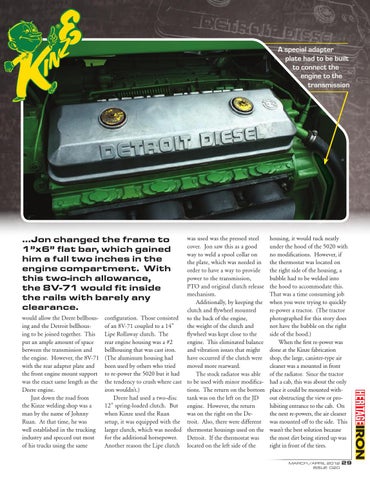A special adapter plate had to be built to connect the engine to the transmission
...Jon changed the frame to 1”x6” flat bar, which gained him a full two inches in the engine compartment. With this two-inch allowance, the 8V-71 would fit inside the rails with barely any clearance.
was used was the pressed steel cover. Jon saw this as a good way to weld a spool collar on the plate, which was needed in order to have a way to provide power to the transmission, PTO and original clutch release mechanism. Additionally, by keeping the clutch and flywheel mounted would allow the Deere bellhous- configuration. Those consisted to the back of the engine, ing and the Detroit bellhousof an 8V-71 coupled to a 14” the weight of the clutch and ing to be joined together. This Lipe Rollaway clutch. The flywheel was kept close to the put an ample amount of space rear engine housing was a #2 engine. This eliminated balance between the transmission and bellhousing that was cast iron. and vibration issues that might the engine. However, the 8V-71 (The aluminum housing had have occurred if the clutch were with the rear adapter plate and been used by others who tried moved more rearward. the front engine mount support to re-power the 5020 but it had The stock radiator was able was the exact same length as the the tendency to crush where cast to be used with minor modificaDeere engine. iron wouldn’t.) tions. The return on the bottom Just down the road from Deere had used a two-disc tank was on the left on the JD the Kinze welding shop was a 12” spring-loaded clutch. But engine. However, the return man by the name of Johnny when Kinze used the Ruan was on the right on the DeRuan. At that time, he was setup, it was equipped with the troit. Also, there were different well established in the trucking larger clutch, which was needed thermostat housings used on the industry and specced out most for the additional horsepower. Detroit. If the thermostat was of his trucks using the same Another reason the Lipe clutch located on the left side of the
housing, it would tuck neatly under the hood of the 5020 with no modifications. However, if the thermostat was located on the right side of the housing, a bubble had to be welded into the hood to accommodate this. That was a time consuming job when you were trying to quickly re-power a tractor. (The tractor photographed for this story does not have the bubble on the right side of the hood.) When the first re-power was done at the Kinze fabrication shop, the large, canister-type air cleaner was a mounted in front of the radiator. Since the tractor had a cab, this was about the only place it could be mounted without obstructing the view or prohibiting entrance to the cab. On the next re-powers, the air cleaner was mounted off to the side. This wasn’t the best solution because the most dirt being stirred up was right in front of the tires. MARCH /APRIL 2012 ISSUE 020
29
